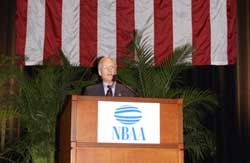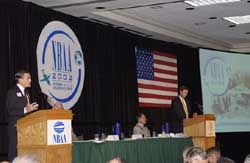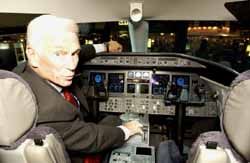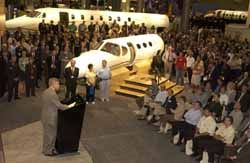 | |
A year ago, the NBAA board of directors reacted to the horror of 9/11 and the ensuing national airspace shutdown by voting to delay the 54th convention of the National Business Aviation Association, a convention already coming together in New Orleans. By the time the rescheduled convention convened in the Big Easy, the business-aviation community, like all of general aviation, was struggling to overcome a plethora of scattershot restrictions and the closure of airports in the Washington, D.C., area to their operations.
Thanks to financial hits many exhibitors took, the display hall paled compared to the prior year’s event; the static display barely qualified for its label. And delegate attendance suffered a hit exceeding 60 percent.
Although the level of business conducted exceeded historical norms, many within the community voiced concerns that this year’s 55th convention would also suffer compared to past years — particularly if the world remained a place laced with a sense of danger and foreboding.
But the opening Tuesday morning of NBAA’s 2002 convention helped erase some of those nagging concerns.
One thousand eleven exhibitors populate the vast, sprawling halls of the Orange County Convention Center, a record for an NBAA convention. Opening-day registration numbers exceeded 25,000 — not a record, but well along toward matching the best-ever attendance of conventions past.
And a flurry of early activities by various vendors set a tone that contrasted sharply with the mood of last year’s terrorist-delayed event.
Plainly put, the NBAA gathering was back, buoyed by heady forecasts of business to come, and sobered by the continuing realities of the changed world general aviation operates within today — a world in which the name “TSA” and the phrase “Homeland Security” remain signs that all is not as it was on September 10 a year ago.
 | |
Opening-Day Crowd | |
And when the word started trickling through the crowds of Tuesday’s further elevation of security measures, the consensus reaction gravitated toward concern for the potential horror of another attack and relief that, at least, the latest rounds of new restrictions appeared unlikely to seriously impact a convention for which most attending were already on-site.
“Dealing with these security considerations and the new agencies involved is almost enough work to warrant a new association all by itself,” noted one Washington-based representative of an aviation trade group. “Right now, we’re happy to just keep things from getting worse — and ecstatic that the community is doing as well is it is.”
NBAA members and delegates paused during the opening general-session Tuesday morning to remember the heroes of Flight 93 in Pennsylvania, and on Wednesday, 9/11/02, the association delayed opening the convention until after observations of the moments when the airliners struck the twin towers of the World Trade Center.
Conversations turned somber during talks about last year’s delayed meeting and the reasons for the delay.
But by all other appearances and actions, the business-aviation community appears to be doing fairly well, all things considered. At least, that’s the mood reflected among the vendors and delegates attending the world’s premier civil-aviation trade show.
Sale-abration, Not Aberration: Business Flying Picks Up
Two more years of declines will precede return to record business
NBAA President Jack Olcott noted that all indicators point toward increases in business-aviation hours flown, flight frequencies, and fractional ownership, as indicators of how strong business aviation remains today, despite terrorist threats and four-digit drops in the major stock indices.
General Aviation Manufacturers Association (GAMA)President Ed Bolen noted that student starts — a critical measure of the health of the pilot population — are also up, about 3 percent, according to the Be-A-Pilot Program.
But these leading indicators amounted to only part of the evidence that general aviation’s health is good and improving. Honeywell contributed to the sense of returning momentum with a forecast predicting sales of nearly 8,000 business turbine aircraft in the coming 10 years. Prognostications from other sources varied slightly in the timing and totals, but all foreshadowed a return to growth in orders in 2004 to 2005, and a return to 2001’s record sales pace in the 2005-2006 timeframe.
“Business, after all, still has to travel, and business aircraft remain the safest, most secure, most convenient, and time-efficient way to travel for business,” noted Olcott.
Planemakers like New Piper, which expects to finish the year with production of about 315 aircraft, hope for a 2003 with no further declines. “We’d be in good shape if we could hold this year’s level,” said Chuck Suma, New Piper’s chairman.
Cessna Aircraft Co., the world’s leading maker of business jets, expects to deliver its 4,000th Citation in the coming year, and recognized its one-millionth customer at the convention Tuesday.
According to returned company chairman Russ Meyer, next year’s Citation production will drop to about 250 after record production of about 300 jets in each of the past two years. Growth should resume in 2004 or so, Meyer said.
And the future for new models remains bullish — an assertion planemakers backed with new-model announcements.
For example, in the 12 days leading up to this convention, Bombardier flew the prototype Learjet 40 on its maiden flight, followed six days later by the first flight of the first production model. Certification of the latest Learjet is expected in 2003, less than 18 months after the model’s launch at Farnborough in late July.
Gulfstream expanded its product line to seven jets — four mid-size and three large-cabin models. Joining the Gulfstream 100 and 200 already in production are the 150, 300, and 400 — with the GV and GV-SP morphing into the 500 and 550. In a sign of investors’ confidence in the business-aviation market, Warren Buffet’s NetJets announced orders for 50 new G150s and options for another 50.
NetJets, the inventor of the fractional-ownership approach to business-jet convenience, also factored heavily in the announcement of another program, the highly anticipated unveiling of a new Cessna Citation, the $5 million CJ3. NetJets penned an order for 100 of the new Citations and added 12 more commitments to its existing unfulfilled order for 18. Between the Cessna and Gulfstream transactions, NetJets committed nearly $2 billion here.
To continue the excitement, Cessna also unveiled its smallest-ever Citation, a $2.3 million cabin-class compact dubbed the Citation Mustang. Certification is expected in 2006, leaving Cessna a bit of time to pick a vendor for an engine — expected to be either Williams-Rolls’ 1,300-pound thrust FJ33 or Pratt & Whitney Canada’s 1,450-pound thrust PW615. Either powerplant should meet the power requirements to give the Mustang its proposed 340-knot cruise speed and 3,100-foot runway abilities.
Clearly, Cessna has taken a flyer to find whether the Citation line can be downsized — without eclipsing the three CJs now in the lineup — and the buyers are responding. The Mustang had already corralled more than 80 commitments — with prospects in the exhibit area asking for the one-page purchase agreement and offering the $10,000 deposit required to secure a position. By year’s end, after showing the mock-up at next month’s AOPA Expo in Palm Springs, Cessna expects purchase commitments to swell to 200.
Elsewhere around the show, other signs of renewed enthusiasm permeated the atmosphere, from Honeywell’s announcement of a new turbofan engine, to new enhanced-vision gear for new and existing jets, to a plethora of other advances that seemingly defy the conventional wisdom that general aviation is struggling to survive.
TSA: We Want You — At The Table
Tom Blank invites general aviation to talk, and open communication
“I’m here to invite the general aviation community to the TSA table,” said Tom Blank, acting associate undersecretary for security, regulation, and policy. Noting that, beyond the immediate victims of 9/11 and their families, no part of American life suffered more in the aftermath than general aviation, Blank stressed the TSA’s desire to work with “stakeholders” like NBAA.
“One of the key themes I want to convey today is that the line of communication between TSA and general aviation is open. You have a voice at TSA.” His assertion was almost eerily prophetic.
Hours later, the TSA showed its willingness to work with GA by meeting with NBAA, AOPA, NATA, EAA, and other aviation groups to brief them on the elevation of security-alert levels later in the day. By the time delegates began to drift off to evening social events, hospitality suites, and the opening-day reception on the exhibit floor, NBAA staff had drafted, polished, and shipped both its own press release on the elevated alert level, and posted information in an alert on the association’s web site.
From Blank’s mouth to action — cooperation in action on the same day as the utterance. We can only hope we need less of it in the future — and that whenever the need arises, the TSA continues to show this level of communication.
More to come …
Scratching the surface today means you get more on Monday
That’s about all we have time to impart from a convention only one-third completed as of this writing. There’s plenty more on the agenda, and the possibility of more surprises beckons us back to the Convention Center early each of the remaining two mornings.
So stay tuned; come Monday, we’ll have more insights, more behind-the-scenes details, and more specifics on the product debuts and service expansions that are making NBAA 2002 look like the breakout event general aviation needs to avoid the doldrums.





































